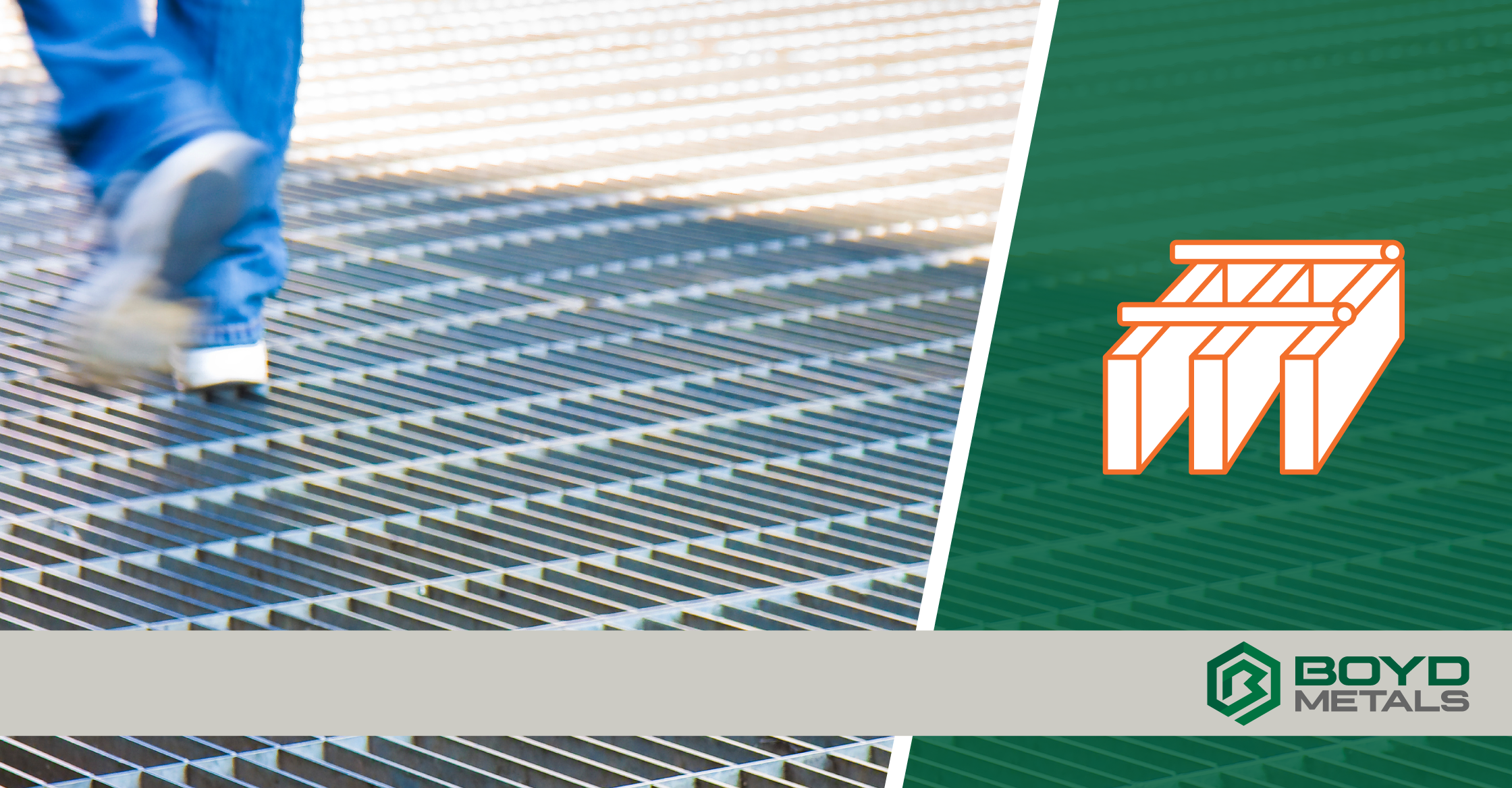To provide a valuable reference for our industry, we explore the essential standards, specifications, and considerations for industrial bar grating applications. From NAAMM and ASTM requirements to material selection and maintenance best practices, this resource provides everything project managers and engineers need to know about bar grating for industrial platforms and walkways.
Due to its strength, durability, and versatility, bar grating is often the industrial steel solution of choice when designing industrial platforms, walkways, and elevated flooring systems. However, navigating the various standards, types, and specifications can be overwhelming for project managers and engineers. This comprehensive guide will walk you through everything you need to know about bar grating standards and applications.
What is Bar Grating?
Bar grating (metal grating) is a prefabricated product consisting of load-bearing parallel bars crossed by perpendicular connecting bars, creating an open grid pattern. It's manufactured from various metals, including carbon steel, stainless steel, and aluminum, making it ideal for industrial flooring, platforms, catwalks, mezzanines, and trench covers.
![Bar Grating Standards: A Metal Service Center Guide for Industrial Applications [Includes Industry Standard Reference Links]](https://blog.boydmetals.com/hs-fs/hubfs/20250501-boyd-inline-1.png?width=2240&height=1169&name=20250501-boyd-inline-1.png)
The open design of bar grating offers several advantages:
- Excellent load-bearing capacity
- Self-cleaning properties (debris falls through)
- Proper drainage
- Ventilation and light transmission
- Non-slip surface options
- Clear visibility to areas below
How Boyd Metals Serves Your Bar Grating Needs
As a leading metal service center in the region, Boyd Metals provides an extensive range of bar grating options to meet your specific project requirements. Their inventory includes numerous variations such as 19W4, 15W4, and 15W2 configurations to accommodate load and span requirements. Customers can choose from various finishes, including painted, unpainted, galvanized, stainless steel, and aluminum. Boyd Metals offers smooth and serrated surfaces to address safety and environmental needs. Beyond supplying standard materials, Boyd Metals provides custom fabrication services to process grating to exact measurements and shapes, ensuring you receive precisely what your project demands without additional on-site modifications.
Key Industry Standards for Bar Grating
Several organizations establish standards for bar grating design, manufacturing, and installation, ensuring safety and consistency across the industry:
NAAMM (National Association of Architectural Metal Manufacturers)
The NAAMM's Metal Bar Grating Manual (MBG 531) is the industry bible for industrial steel bar grating specifications. This comprehensive standard:
- Establishes terminology and definitions
- Outlines design requirements
- Specifies tolerance limits
- Provides load tables for different bar grating configurations
- Details of manufacturing processes
- Sets quality control standards
ASTM International Standards
Several ASTM standards apply specifically to bar grating:
- ASTM A1011/A1011M: Standard specification for steel sheet and strip, hot-rolled, carbon, structural, high-strength low-alloy, high-strength low-alloy with improved formability, and ultra-high strength
- ASTM A36/A36M: Standard specification for carbon structural steel used in bearing bars
- ASTM A653/A653M: Standard specification for steel sheet, zinc-coated (galvanized) for grating applications
- ASTM A666: Standard specification for annealed or cold-worked stainless steel for stainless gratings
- ASTM B221: Standard specification for aluminum alloys in extruded form for aluminum gratings
ANSI Safety Standards
The American National Standards Institute provides critical safety guidelines:
- ANSI A1264.1: Safety Requirements for Workplace Walking/Working Surfaces
- ANSI A14.3: Safety Requirements for Fixed Ladders, including specifications for surrounding gratings
OSHA Regulations
The Occupational Safety and Health Administration establishes regulations that impact grating applications:
- 29 CFR 1910.23: Guarding floor and wall openings and holes
- 29 CFR 1910.24: Fixed industrial stairs
- 29 CFR 1926.501: Duty to have fall protection
- 29 CFR 1910.22: Walking-working surfaces general requirements
Types of Bar Grating
Based on the Fabrication Method
1. Welded Bar Grating
Welded bar grating is manufactured by placing load-bearing bars (bearing bars) at specified intervals and joining them with perpendicular cross bars using resistance welding. This process creates strong, uniform joints at each intersection. The stainless steel material used in this application offers exceptional corrosion resistance for demanding environments.
Key Features:
- Highest load-carrying capacity
- Available in steel, stainless steel, and aluminum
- Standard spacing: 1-3/16" centers for bearing bars
- Cross bar spacing is typically 4" centers
- Standard panel sizes: 24' x 3' or 24' x 4'
2. Pressure-Locked Grating
The cross bars are hydraulically pressed into slots pre-punched in the bearing bars in a pressure-locked grating. This process creates a mechanical lock without welding.
Key Features:
- Excellent for corrosive environments (no heat-affected zones)
- Suitable for applications requiring non-magnetic properties
- Commonly available in stainless steel and aluminum
- Neat appearance with flush top surface
3. Riveted Grating
Riveted grating features cross bars attached to notched bearing bars using rivets to secure the connection.
Key Features:
- Traditional grating type, less common in new installations
- Suitable for specialized applications with vibration concerns
- Available in steel and aluminum
Based on Surface Treatment
1. Serrated Bar Grating
Serrated bar grating features bars bearing serrations (teeth or ridges) on the top surface.
Key Features:
- Excellent slip resistance in wet, oily, or icy conditions
- Typically increases the slip resistance coefficient by 30-40%
- Important for high-risk environments
- Common in outdoor applications, food processing, and oil/gas facilities
2. Smooth Bar Grating
Smooth bar grating has flat, non-serrated bearing bars.
Key Features:
- Easier to clean and maintain
- More comfortable for foot traffic
- Better for environments where dirt and debris collection is a concern
- Common in indoor applications with dry conditions
3. Painted Bar Grating
Painted bar grating has a protective coating applied to the metal surface.
Key Features:
- Enhanced corrosion resistance
- Color-coding capabilities for safety or identification
- Standard colors include safety yellow and black
- Common coating: fusion-bonded epoxy or powder coating
- Typically requires ASTM A123-compliant coating processes
Choosing the right bar grating for industrial platforms and walkways requires careful consideration of load requirements, environmental conditions, safety standards, and maintenance needs. By understanding the various NAAMM, ASTM, ANSI, and OSHA standards, project managers and engineers can select appropriate grating specifications that ensure safe, durable, and cost-effective installations.
Whether you opt for serrated steel grating for maximum slip resistance in outdoor environments or smooth aluminum grating for corrosion resistance in food processing facilities, adherence to industry standards and proper installation practices will ensure your metal grating system provides safe, reliable service for many years.
Remember, while initial cost is always a consideration, the long-term performance and safety of your walkways, platforms, and industrial flooring depend on selecting the right bar grating specification for your specific application.



